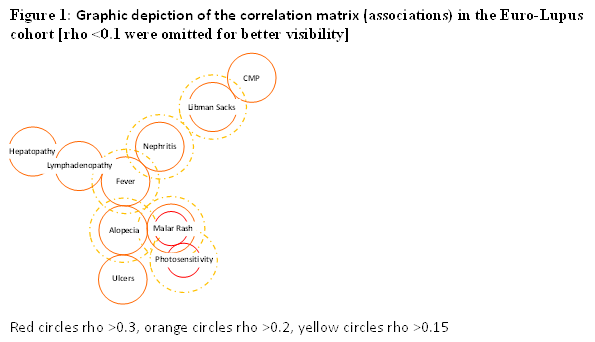Session Information
Date: Monday, November 6, 2017
Title: Systemic Lupus Erythematosus – Clinical Aspects and Treatment Poster II: Damage and Comorbidities
Session Type: ACR Poster Session B
Session Time: 9:00AM-11:00AM
Background/Purpose:
An EULAR/ACR –sponsored project is currently developing new weighted SLE classification criteria including laboratory/clinical items. Combinations of symptoms appear commonly in SLE arguing against lupus as one single disease entity. Moreover, if such “clusters (buckets)” exist this would distort the weightings. It is important to ensure the independence of potential criteria items from each other. We evaluated the interrelationship between candidate criteria items in 2 cohorts.
Methods:
International Early SLE Cohort: 389 SLE patients diagnosed within the last 3 years, from 7 academic centers in Asia (Manila), Europe (Berlin, Pisa), North America (Boston, Chicago, Toronto) and South America (São Paulo). Data on all ACR 1997, SLICC 2012 and 30 additional items were collected.
Tetrachoric correlation coefficients (rho) assessed the association between different items of the same domain (rho 0.2-0.3 borderline and rho > 0.3 meaningful correlation). Mucocutaneous, hematologic and neurological items were examined to avoid overrepresentation.
Euro-Lupus Cohort: 1000 SLE patients from 12 universities (7 European countries). The baseline patient data set was used for the analysis. The complete correlation matrix of the Euro-Lupus clinical data was analyzed. The significant associations identified in the international cohort were validated in the Euro-Lupus cohort.
Results:
Mucocutaneous items: Only malar rash resulted in a correlation ≥ 0.2 with photosensitivity, alopecia, and oral ulcers. Neurological items: Only seizure and the non-criteria symptom migraine showed a correlation ≥ 0.2. Serologic items: A high degree of correlation was found for anti-Sm with anti-RNP, and anti-dsDNA, for anti-Ro with anti-La, and between anti-phospholipid antibodies. Other correlations are represented in Table 1.
With the exception of the correlation between malar rash and oral ulcers, all associations between mucocutaneous manifestations were independently confirmed in the Euro-Lupus cohort.
Correlation matrix of the Euro-Lupus cohort: rho ≥ 0.2 were only found for fever with alopecia and with nephritis, for lymphadenopathy with fever and with hepatitis, and for Libman-Sacks endocarditis with cardiomyopathy (Figure 1).
Conclusion:
|
Table 1. Correlation with rho ≥ 0.2 among cutaneous manifestations, neurological and serologic in the international early SLE cohort |
||
|
Manifestations |
Items |
Tetrachoric rho International cohort |
|
Mucocutaneous |
Malar rash vs alopecia |
0.250 |
|
Malar rash vs photosensitivity |
0.299 |
|
|
Malar rash vs oral ulcer |
0.216 |
|
|
Neuro |
Seizure vs Migraine |
0.217 |
|
Serologic |
Anti-Sm vs Anti-dsDNA |
0.334 |
|
Anti-Sm vs anti-Ro |
0.240 |
|
|
Anti-Sm vs anti-RNP |
0.606 |
|
|
Anti-Ro vs anti-La |
0.541 |
|
|
Anti-Cardiolipin IgG vs IgM |
0.382 |
|
|
Anti-Cardiolipin IgG vs LAC |
0.286 |
|
|
Anti-Cardiolipin IgG vs anti-beta2-GPI |
0.510 |
|
|
Anti-Cardiolipin IgM vs anti-beta2-GPI |
0.403 |
|
|
LAC vs anti-beta2-GPI |
0.256 |
|
|
Anti-dsDNA vs anti-cardiolipin IgM |
0.219 |
|
|
Anti-dsDNA vs anti-cardiolipin IgM |
0.219 |
|
|
All p were < 0.001 List of all studied items but not represented in this table: Discoid rash, subacute rash, stroke, transitory attack, cognitive impairment, seizure, psychosis, migraine, and ANA. |
||
To cite this abstract in AMA style:
Touma Z, Cervera R, Brinks R, Tani C, Hoyer BF, Costenbader KH, Lorenzoni V, Sebastiani G, Navarra SV, Bonfa E, Ramsey-Goldman R, Tedeschi SK, Doerner T, Johnson S, Aringer M, Mosca M. Associations Among Classification Criteria Items within Systemic Lupus Erythematosus [abstract]. Arthritis Rheumatol. 2017; 69 (suppl 10). https://acrabstracts.org/abstract/associations-among-classification-criteria-items-within-systemic-lupus-erythematosus/. Accessed .« Back to 2017 ACR/ARHP Annual Meeting
ACR Meeting Abstracts - https://acrabstracts.org/abstract/associations-among-classification-criteria-items-within-systemic-lupus-erythematosus/

